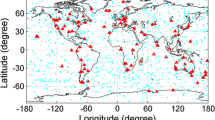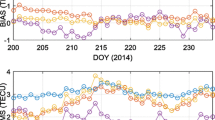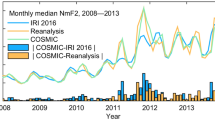Abstract
The FORMOSAT-3/COSMIC satellite constellation has become an important tool toward providing global remote sensing data for sounding of the atmosphere of the earth and the ionosphere in particular. In this study, the electron density profiles are derived using the Abel transform inversion. Some drawbacks of this transform in LEO GPS sounding can be overcome by considering the separability concept: horizontal gradients of vertical total electron content (VTEC) information are incorporated by the inversion method, providing more accurate electron density determinations. The novelty presented in this paper with respect to previous works is the use of the phase change between the GPS transmitter and the LEO receiver as the main observable instead of the ionospheric combination of carrier phase observables for the implementation of separability in the inversion process. Some of the characteristics of the method when applied to the excess phase are discussed. The results obtained show the equivalence of both approaches but the method exposed in this work has the potentiality to be applied to the neutral atmosphere. Recent FORMOSAT-3/COSMIC data have been processed with both the classical Abel inversion and the separability approach and evaluated versus colocated ionosonde data.








Similar content being viewed by others
References
Anthes RA, Bernhardt PA, Chen Y, Cucurull L, Dymond KF, Ector D, Healy SB, Ho SP, Hunt DC, Kuo YH, Liu H, Manning H, McCormick C, Meehan TK, Randel WJ, Rocken C, Schreiner WS, Sokolovskiy SV, Syndergard S, Thompson DC, Trenberth KE, Wee TK, Yen NL, Seng Z (2008) The COSMIC/FORMOSAT-3 mission: early results. Bull Am Met Soc 89:313–333. doi:10.1175/BAMS-89-3-313
Badley PA, Dudeney JR (1973) A simple model of the vertical distribution of electron concentration in the ionosphere. J Atmos Terr Phys 35:2131–2146
Davies K (1990) Ionospheric Radio, Chapter 5, IEE Electromagnetic Waves Series 31, Peter Peregrinus Ltd., ISBN 0 86341 186 X, pp 124–154
Dudeney JR (1983) The accuracy of simple methods for determining the height of the maximum electron concentration of the F2-layer from scaled ionospheric characteristics. J Atmos Terr Phys 45:629–640
Garcia-Fernandez M (2004) Contributions to the 3D ionospheric sounding with GPS data, Doctoral Thesis, Technical University of Catalonia (UPC), B.45104-2004/84-688-8156-2
Hajj GA, Romans LJ (1998) Ionospheric electron density profiles obtained with the global positioning system: results from the GPS/MET experiment. Radio Sci 33(1):175–190
Hajj GA, Ao CO, Iijima BA, Kuang D, Kursinski ER, Mannucci AJ, Meehan TK, Romans LJ, de la Torre Juarez M, Yunck TP (2004) CHAMP and SAC-C Atmospheric occultation results and intercomparisons, J Geophys Res 109(D6). ISSN 0148-0227, pp D06109.1–D06109.24
Hernandez-Pajares M, Juan JM, Sanz J (2000) Improving the Abel inversion by adding ground data LEO radio occultations in the ionospheric sounding. Geophys Res Lett 27:2743–2746
Hernandez-Pajares M, Juan JM, Sanz J, Orus R, Garcia-Rigo A, Feltens J, Komjathy A, Schaer SC, Krankoswki A (2009) The IGS VTEC maps: a reliable source of ionospheric information since 1998, J Geod. doi:10.007/s00190-008-0266-1
Lei J, Syndergaard S, Burns AG, Solomon SC, Wang W, Zeng Z, Roble RG, Wu Q, Kuo YH, Holt JM, Zhang SR, Hysell DL, Rodrigues FS, Lin CH (2007) Comparison of COSMIC ionospheric measurements with ground-based observations and model predictions: preliminary results. J Geophys Res 112:A07308. doi:10.1029/2006JA012240
Rishbeth H, Sedgemore-Schulthess KJF, Ulich Th (2000) Annual and semiannual variations in the height of the ionospheric F2-layer. Ann Geophys 18(3):285–299
Schaer S, Gurtner W, Feltens J (1998) IONEX: the IONosphere Map EXchange. Format Version 1, Proceedings of the 1998 IGS Analysis Centres Workshop, ESOC, Darmstadt, Germany, Feb 9–11, pp 233–247
Schreiner S, Sokolovskiy SV, Rocken C, Hunt DC (1999) Analysis and validation of GPS/MET in the ionosphere. Radio Sci 34(4):949–966
Schreiner S, Sokolovskiy SV, Rocken C, Hunt DC (2008) Quality assessment of GPS radio occultation data from the COSMIC/FORMOSAT-3, CHAMP, GRACE missions, FORMOSAT-3/COSMIC 2008 Workshop, Taipei, Taiwan, Oct 1–3
Shimazaki T (1955) World-wide daily variations in the height of the maximum electron density of the ionospheric F2-layer. J Radio Res Lab (Japan) 2(7):85–97
Wickert J, Reigber Ch, Beyerle G, König R, Marquardt C, Schmidt T, Grunwaldt L, Galas R, Meehan TK, Melbourne WG, Hocke K (2001) Atmosphere sounding by GPS radio occultation: first results from CHAMP. Geophys Res Lett 28:3263–3266
Wickert J, Beyerle G, Hajj GA, Schwieger V, Reigber Ch (2002) GPS radio occultation with CHAMP: Atmospheric profiling utilizing the space-based single difference technique, Geophys Res Lett 29(8), doi: 10.1029/2001GL013982
Zhang SR, Fukao S, Oliver WL (1999) Data modeling and assimilation studies with the MU radar. J Atmos Terr Phys 61:563–583
Acknowledgments
The authors would like to express their gratitude to the University Corporation for Atmospheric Research (UCAR), the National Space Organization (NSPO) in Taiwan for the availability of FORMOSAT-3/COSMIC constellation data, the International GNSS Service (IGS) for making available IONEX files, the source of ionosonde data SPIDR and, Dr. David Altadill at Ebro Observatory for providing calibrated AS00Q ionosonde data. This work has been partially supported by the Spanish Ministry of Science and Technology and the European Social Funds under the program “Personal Técnico de Apoyo”, and the IBER-WARTK project ESP2007-62676.
Author information
Authors and Affiliations
Corresponding author
Appendix
Appendix
In order to implement separability to bending angles, it would be required to have a proportional relationship between bending angles and electron densities that would allow, for two consecutive concentric spherical layers, to write the increment of bending angles as the corresponding increment of electron densities within the two layers. Unfortunately, this is not the case and some approximations are needed to derive such proportionality. Details are given later.
We start from the definition of the ionosphere’s refractive index n derived by Appleton and Hartree, and accept that it can be approximated by first-order form with an accuracy better than 0.1% (Davies 1990),
where f is the system operating frequency and f p , the plasma frequency that is defined by
where e stands for the electron charge, \( \varepsilon_{0} \) the permittivity of free space and, m the rest mass of an electron. Hence, the expression in (12) now becomes
Differentiating the latter equation gives
Considering the nominal value of GPS frequency L 1 \( (f_{1} = 1575.42\,{\text{MHz}}) \) and the plasma frequency \( (f_{p} = 20\,{\text{MHz}}) \), the denominator in (16) can be approximated by
Substituting (17) into (16) leads to
The latter equation provides the key to separability implementation when using the L 1 bending angle α 1 as input data for the inversion since it will give the proportionality relationship between bending angle and electron density.
Using Bouguer’s formula, which is equivalent to Snell’s law in a spherically symmetric medium, we can establish the relationship of bending angle α and the refractive index n
The symbol r stands for the geocentric distance, θ the zenith angle of the LOS vector and a the impact parameter. Considering a layered ionosphere, the change between different layers is obtained by differentiating (19)
Rearranging the terms in previous equation gives
The first term in (21) takes into account the change in the ray path due to the changes in the refractive index while the second depends on the geometric variations. Actually, the first term provides the definition of the bending angle change in terms of n,
Recalling the expression in (18), it can be derived that the increment of bending angle between consecutive layers with different refractive index is
Therefore, the total bending angle for one ray path would be obtained by adding all bending angle contributions
Rights and permissions
About this article
Cite this article
Aragon-Angel, A., Hernandez-Pajares, M., Zornoza, J.M.J. et al. Improving the Abel transform inversion using bending angles from FORMOSAT-3/COSMIC. GPS Solut 14, 23–33 (2010). https://doi.org/10.1007/s10291-009-0147-y
Received:
Accepted:
Published:
Issue Date:
DOI: https://doi.org/10.1007/s10291-009-0147-y




